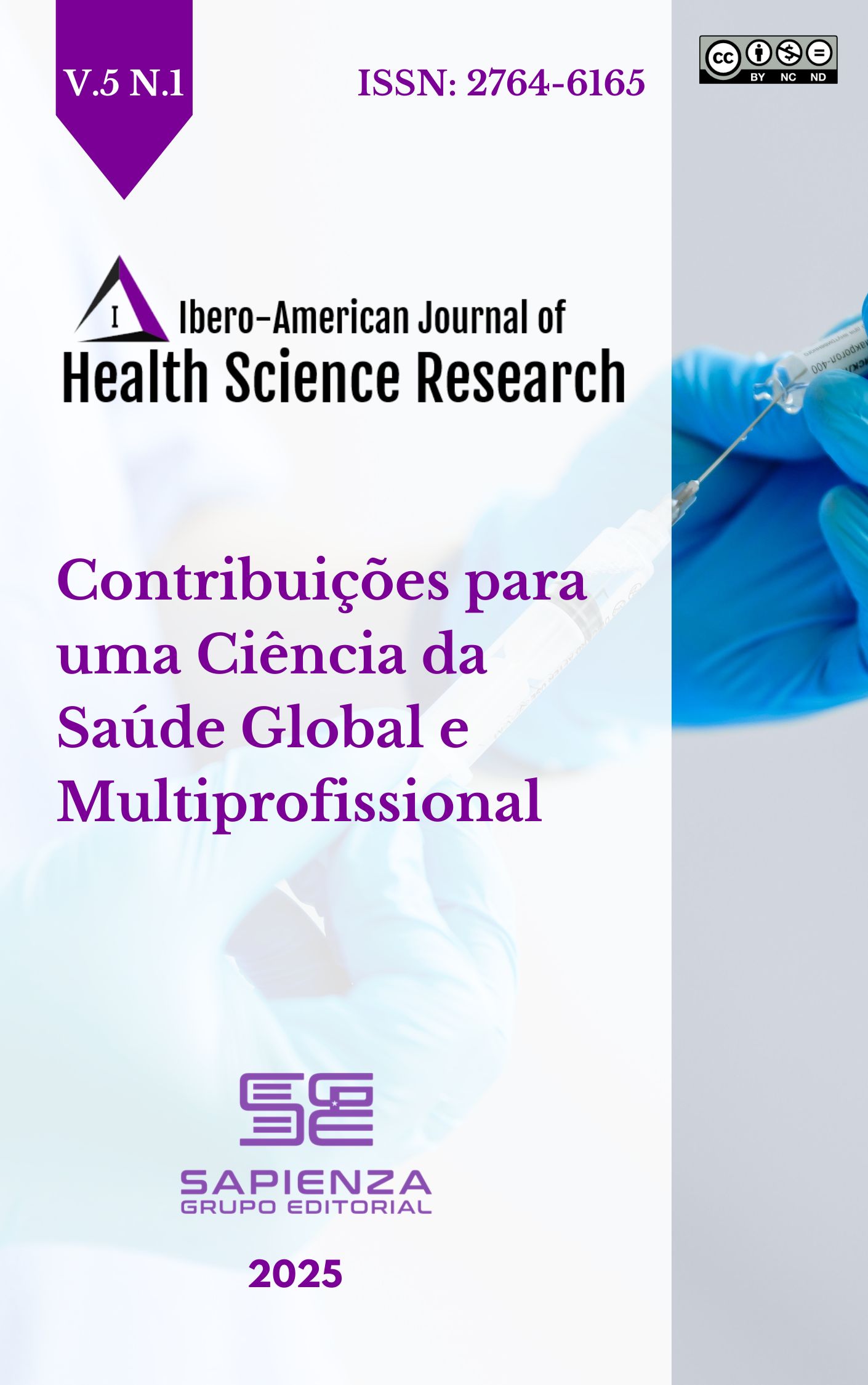Advanced surgical and reconstructive techniques for abdominal wall necrosis secondary to severe infections: a systematic review of functional and aesthetic outcomes
DOI:
https://doi.org/10.56183/iberojhr.v5i1.724Palavras-chave:
Necrosis, Abdominal Wall, Systematic Review.Resumo
Abdominal wall necrosis secondary to severe infections presents reconstructive challenges and need advanced surgical techniques for accomplishing functional restoration and aesthetic outcomes. We conducted this systematic review to evaulate various reconstructive approaches including vacuum-assisted closure (VAC) therapy, regional and free flap transfers, biological and synthetic mesh implantation and posterior component separation techniques. Our findings indicate that mesh reinforcement like polypropylene and composite mesh provides structural stability but carries risks of infection and recurrence. Perforator-based fasciocutaneous and regional myocutaneous flaps have also shown superior vascularisation and reduced hernia recurrence though technical complexity and donor site morbidity remain concerns. Biological meshes such as acellular dermal matrix and porcine collagen also offer promising infection-resistant alternatives. Free flap transfers such as anterolateral thigh or latissimus dorsi flaps are emerged as effective techniques for large defects but demands microsurgical expertise. Posterior component separation with transversus abdominis release (TAR) enables tension-free fascial closure with improved durability. So, we came to a conclusion that abdominal wall necrosis following severe infections necessitates a range of reconstructive approaches. It is clear that direct closure is feasible in minor defects but limited by tension risks. Component separation techniques, including anterior and posterior approaches, enhance fascial mobilization with reported success rates exceeding 80%. Mesh-based reconstructions using synthetic or biological materials provide durability but carry infection risks. Negative pressure wound therapy (NPWT) optimizes wound bed conditions and reduce complications and improving graft integration. Pedicled flaps, such as rectus abdominis or anterolateral thigh flaps are effective to restore coverage with viable tissue and achie superior aesthetic outcomes. Free flaps are complex but offer critical reconstruction with a 90% success rate. Hybrid techniques integrating NPWT, mesh and flap reconstruction enhance functional integrity with outcomes varying based on defect size and infection control.
Referências
Ainsworth, P. D., & De Cossart, L. (2010). Abdominal wall infected ischemic necrosis mimicking necrotizing fasciitis. Annals of Vascular Surgery, 24(4), 553.e7-553.e8. https://doi.org/10.1016/j.avsg.2009.09.015
Al Zarouni, M. (2019). Abdominal wall reconstruction with the two-step technique: Procedure optimization and three-year follow-up in 26 surgeries. Plastic and Reconstructive Surgery - Global Open, 7(5), e2182. https://doi.org/10.1097/GOX.0000000000002182
Birolini, C., de Miranda, J. S., Tanaka, E. Y., Utiyama, E. M., Rasslan, S., & Birolini, D. (2020). The use of synthetic mesh in contaminated and infected abdominal wall repairs: challenging the dogma—A long-term prospective clinical trial. Hernia, 24(2), 307-323. https://doi.org/10.1007/s10029-019-02035-2s
Boukovalas, S., Sisk, G., & Selber, J. C. (2018). Abdominal wall reconstruction: An integrated approach. Seminars in Plastic Surgery, 32(3), 107–119. https://doi.org/10.1055/s-0038-1667062
Chamseddine, N., Aghar, H., Haidar, Z., Aoud, G., Ibrahim, A., & Ghazeeri, G. (2024). Polymicrobial necrotizing fasciitis after a primary cesarean section in a low-risk patient: A case report and literature review. International Journal of Surgery Case Reports, 124, 110326. https://doi.org/10.1016/j.ijscr.2024.110326
Cocanour, C. S., Chang, P., Huston, J. M., Adams, C. A., Diaz, J. J., Wessel, C. B., Falcione, B. A., Bauza, G. M., Forsythe, R. A., & Rosengart, M. R. (2017). Management and novel adjuncts of necrotizing soft tissue infections. Surgical Infections, 18(3), 250–272. https://doi.org/10.1089/sur.2016.200
Fernández, J. Á., Alconchel, F., Frutos, M. D., Gil, E., Gómez-Valles, P., Gómez, B., Fernández-Pascual, C., Muñoz-Romero, F., Puertas, P., Valcárcel, A., & García, J. (2024). Combined use of composite mesh and acellular dermal matrix graft for abdominal wall repair following tumour resection. World Journal of Surgical Oncology, 22, Article 226. https://doi.org/10.1186/s12957-024-03507-1
Haidar, M. G. M., Sharaf, N. A. H., Haidar, F. M., & Sukaina, M. (2023). Impact of combined component separation technique and shoelace repair on big midline abdominal wall defect. Asian Journal of Surgery, 46(10), 4363-4370. https://doi.org/10.1016/j.asjsur.2022.12.157
Hodgkinson, J. D., Maeda, Y., Leo, C. A., Warusavitarne, J., & Vaizey, C. J. (2017). Complex abdominal wall reconstruction in the setting of active infection and contamination: A systematic review of hernia and fistula recurrence rates. Colorectal Disease, 19(4), 319-330. https://doi.org/10.1111/codi.13609
Hope, W. W., Abdul, W., & Winters, R. (2023). Abdominal wall reconstruction. In StatPearls. StatPearls Publishing. Retrieved from https://www.ncbi.nlm.nih.gov/books/NBK431108/
Jang, J., Jeong, S., Han, S., & Kim, W. (2013). Reconstruction of extensive abdominal wall defect using an eccentric perforator‐based pedicled anterolateral thigh flap: A case report. Microsurgery, 33(6), 482–486. https://doi.org/10.1002/micr.22117
Kimata, Y., Uchiyama, K., Sekido, M., Sakuraba, M., Iida, H., Nakatsuka, T., & Harii, K. (1999). Anterolateral thigh flap for abdominal wall reconstruction. Plastic and Reconstructive Surgery, 103(4), 1191-1197.
Lepivert, J., Alet, J., Michot, A., Pélissier, P., & Pinsolle, V. (2014). Reconstruction de la paroi abdominale par un lambeau propeller issu de l’artère épigastrique supérieure : cas clinique. Annales De Chirurgie Plastique Esthétique, 59(5), 360–363. https://doi.org/10.1016/j.anplas.2014.04.003
Liang, A., Idowu, M. B., Eskind, S. J., & Patel, S. S. (2024). Necrotizing fasciitis Post-Cesarean section leading to transabdominal hysterectomy. American Journal of Perinatology Reports, 14(03), e235–e238. https://doi.org/10.1055/a-2414-7696
Minor, S., Brown, C. J., Rooney, P. S., Hodde, J. P., Julien, L., Scott, T. M., Karimuddin, A. A., Raval, M. J., & Phang, P. T. (2020). Single-stage repair of contaminated hernias using a novel antibiotic-impregnated biologic porcine submucosa tissue matrix. BMC Surgery, 20(1), 58. https://doi.org/10.1186/s12893-020-00715-w
Misiakos, E. P., Bagias, G., Patapis, P., Sotiropoulos, D., Kanavidis, P., & Machairas, A. (2014). Current concepts in the management of necrotizing fasciitis. Frontiers in Surgery, 1. https://doi.org/10.3389/fsurg.2014.00036
Moura, J., Madureira, P., Leal, E., Fonseca, A., & Carvalho, E. (2019). Immune aging in diabetes and its implications in wound healing. Clinical Immunology, 200, 43–54. https://doi.org/10.1016/j.clim.2019.02.002
Pinheiro, R. S., Andraus, W., Fortunato, A. C., Galvão, F. H. F., Nacif, L. S., Waisberg, D. R., Arantes, R. M., Lee, A. D., Rocha-Santos, V., Martino, R. B., Ducatti, L., Haddad, L. B. P., Bezerra, R. O. F., & Carneiro-D'Albuquerque, L. A. (2022). Vacuum-assisted closure for defects of the abdominal wall after intestinal transplantation. Frontiers in Transplantation, 1, 1025071. https://doi.org/10.3389/frtra.2022.1025071
Pogson-Morowitz, K., Fimbres, D. P., Barrow, B. E., Oleck, N. C., & Patel, A. (2024). Contemporary abdominal wall reconstruction: Emerging techniques and trends. Journal of Clinical Medicine, 13(10), 2876. https://doi.org/10.3390/jcm13102876
Schena, C. A., De’Angelis, G. L., Carra, M. C., Bianchi, G., & De’Angelis, N. (2022). Antimicrobial challenge in acute care surgery. Antibiotics, 11(10), 1315. https://doi.org/10.3390/antibiotics11101315
Wallace, H. A., & Perera, T. B. (2023, February 21). Necrotizing fasciitis. StatPearls - NCBI Bookshelf. https://www.ncbi.nlm.nih.gov/books/NBK430756/
Downloads
Publicado
Como Citar
Edição
Seção
Licença
Copyright (c) 2025 Jorge Luis Rivera Gastelum, Brayan Uriel Huerta Catalán, Roberto Kevin Galan Orozco, Ariadny Patricia Requena Salomón, Andrea Virginia Rivera Aguirre, Isabella Ballesteros Santos, Carol Alexandra Sánchez Martínez, Arahi Gabriela Cueller Ocampo

Este trabalho está licenciado sob uma licença Creative Commons Attribution-NonCommercial-NoDerivatives 4.0 International License.



